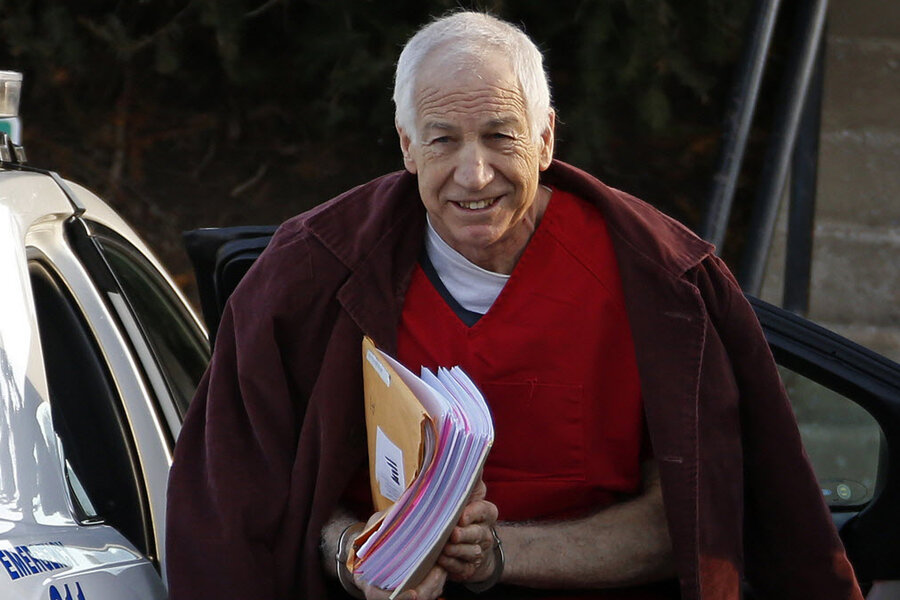Sandusky victim settles with Penn State
Loading...
| Harrisburg, Pa.
A young man who testified he was fondled by former Penn State assistant football coach Jerry Sandusky has reached a settlement that gives him some peace of mind while putting the university in a better position to recover the money through a third party, the man's attorney says.
The settlement is the first among dozens of claims made against the school amid the Sandusky child sex abuse scandal.
The Philadelphia Inquirer first reported that the young man known as "Victim 5," who took the stand at Sandusky's criminal trial and sentencing last year, settled for several million dollars.
Attorney Tom Kline confirmed the deal to The Associated Press on Saturday, but would not specify the dollar amount. He said the parties signed off on the agreement Friday.
Kline said his 25-year-old client was relieved and expected to receive the money within a month. The man identified himself for his testimony, but AP generally does not identify people who are victims of sex crimes.
The paper reported the deal is the first of 26 settlements expected soon among 31 young men who have pressed claims over Sandusky's actions and the school's response.
Kline told the AP that as part of the agreement, his client assigned his claim to Penn State, effectively giving the university a better chance to recover the money from other parties, such as The Second Mile, a charity for at-risk youth that Sandusky founded.
University officials "left themselves a wide open road to recover a significant amount of this money back from their insurers and Second Mile. And we support that," Kline said.
Michael Rozen, one of the lawyers brought in by Penn State to resolve the civil claims, told the paper that Victim 5's case was considered among the more serious because the abuse occurred in August 2001, months after top school officials were informed by a graduate assistant that he saw Sandusky assaulting a boy in a team shower.
"The pivotal issue from the university's perspective in dealing with the victims is where the incident occurred and when it occurred proximate to the 2001 shower incident," Rozen told the paper.
A spokesman for the university declined comment Saturday on the deal, saying the school "continues to make progress on multiple settlements."
At Sandusky's trial, Victim 5 testified that he met the coach at a Second Mile camp in 1999 and went to Penn State games with him. He said that Sandusky groped him in the showers during a workout.
Kline said the agreement does not prevent Victim 5, who lives outside Philadelphia, from talking or writing about his experience, although he has no plans to do so.
"We hope that there is closure, but I can tell you on his behalf that he understands there (are) continuing proceedings, because this case has had, and continues to have, many long tentacles," Kline said.
Victim 5 was among eight young men who testified at Sandusky's trial about abuse that included fondling and rape, including incidents on school property.
Penn State announced a year ago — the day Sandusky was convicted of 45 criminal counts — that it hoped to compensate his victims fairly and quickly. Penn State'strustees have authorized some $60 million to be used for settlements.
Sandusky, 69, is serving a 30- to 60-year state prison sentence for child molestation and related offenses.
He spent three decades at Penn State under former head coach Joe Paterno, and met some of his victims through The Second Mile, which he continued to operate after he retired from Penn State in 1999.
A 1998 complaint about Sandusky showering with a boy — one of those who testified against him — was investigated by university police but no charges were filed. A graduate assistant, Mike McQueary, witnessed a different incident in the team shower in 2001 and notified Paterno and other high-ranking school officials, but police were not called.
The response of university leaders, including Paterno, was heavily criticized in a report commissioned by the school last year. Paterno died in January 2012, but criminal charges for an alleged cover-up are pending against three others: former president Graham Spanier, retired vice president Gary Schultz and retired athletic director Tim Curley. All three deny the allegations.
Penn State had fostered an image of a model football program under Paterno, whose statue outside the football stadium was taken down after the scandal broke.
The school has spent nearly $50 million on the Sandusky scandal, not including any payments to the victims and accusers





